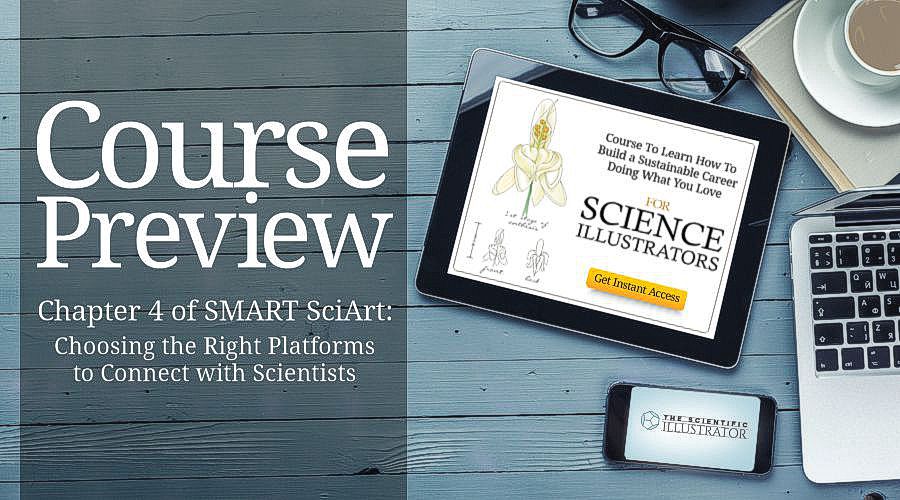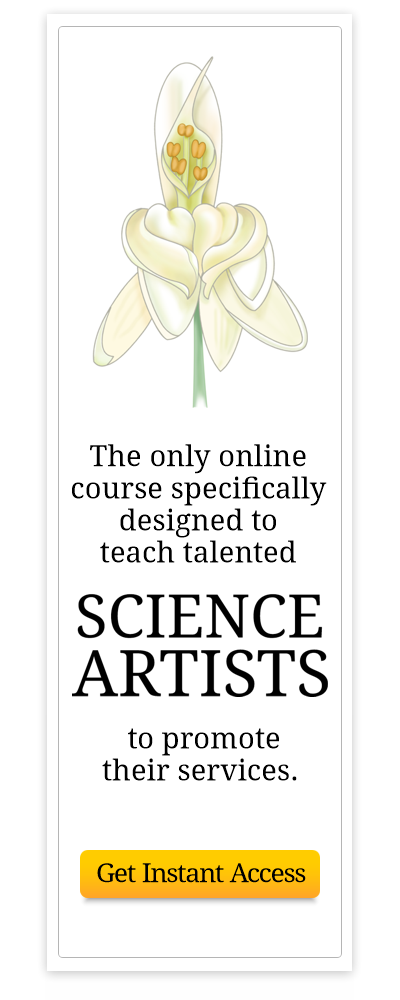
Scientific Illustrator: Choose the Right Platforms to Connect with Scientists
If you’ve ever poured your heart into an illustration, shared it online, and heard only crickets—you’re not alone. One of the most common struggles I hear from early-career scientific illustrators is this:
“I’m creating high-quality work, but scientists aren’t seeing it.”
It’s not a reflection of your talent. It’s often a reflection of where you’re showing up.
That’s why Chapter 4 of the SMART SciArt course focuses entirely on helping you choose the right platforms—not only based on where your artwork looks best, but where your ideal clients already spend their time.
Let’s take a gentle peek into what we explore in this chapter—and why this could be a turning point in how you build visibility and trust in your scientific illustration career.
A Shift in Mindset: From Showcasing to Connecting
As a scientific illustrator it is tempting to choose platforms based on visual appeal—places like Instagram, Behance, or even Pinterest— to find new clients.
These are wonderful for building a portfolio or growing a fanbase, and they absolutely have their place.
But if your goal as a scientific illustrator, is to get hired by scientists or research institutions, there’s a subtle but important shift that needs to happen:
👉 You’re not just looking for platforms that showcase your art—you’re looking for platforms where scientists discover, share, and discuss their work.
Because that’s where relationships begin. That’s where visibility turns into opportunity.
In this chapter, I walk you through how to spot those spaces and how to approach them in a way that feels genuine and aligned with your strengths. We focus on connection, not performance.
Why Scientists Use Online Platforms
Scientists are online for a few very specific reasons. Understanding these reasons is the key to knowing how—and where—you fit in.
In Chapter 4, we explore the top three motivations researchers have when using digital platforms:
- To Share and Discover Research
Platforms like ResearchGate, Academia.edu, and Figshare allow researchers to upload preprints, datasets, and publications. This is where they track the latest findings and make their work visible to peers. - To Network and Collaborate
Scientists use these spaces to find collaborators, co-authors, field partners—and yes, even visual communicators who can help translate their work into something more accessible. - To Contribute to Science Communication
Many researchers are deeply motivated to make their science more public and approachable. If you can support that goal, your illustrations become part of their impact strategy.
When you show up in the spaces where these motivations play out, your presence becomes purposeful—not just decorative.
But What If I Don’t Have a Research Paper?
This is a common concern among scientific illustrators—and one I personally understand. Some platforms, like ResearchGate, require a published paper to create an account.
That can feel like a wall keeping you out of the room where decisions are being made.
In Chapter 4, I share several realistic workarounds for these barriers. We talk about:
- Which platforms are accessible to non-researchers
- How to observe and contribute to academic discussions without publishing papers
- What to do when you’re locked out—and how to find adjacent spaces where collaboration still thrives
You don’t need to pretend to be a scientist. You just need to understand how to show up as a valuable partner in science communication.
Two Platforms, Two Strategies
Another important part of this chapter is exploring two powerful platforms—Academia.edu and ResearchGate—through the lens of visibility and opportunity. I show you:
- How to optimize your profile for trust and clarity.
- What insights and analytics are available (so you know what’s working).
- The strategies for building meaningful relationships on each platform.
You’ll come away with a clear idea of where to focus your time, and how to take your first steps with confidence.
Ready to Learn How to Do It All?
If you’ve been spinning your wheels trying to “grow your audience” or “get discovered as scientific illustrator” online, this chapter may offer the grounding you’ve been looking for.
It’s not about showing up everywhere—it’s about showing up in the right places, with intention, warmth, and clarity.
Inside the course SMART SciArt, I walk you through each step—from choosing your platforms to crafting a presence that feels natural and trustworthy.
No pushy marketing tactics. Just thoughtful, practical tools to help you get your work seen by the people who need it most.
Whenever you’re ready, I’d love to help you build the professional visibility your work truly deserves.
Thanks for reading!
If this article spoke to you, consider bookmarking the blog or sharing it with a fellow illustrator. And if you're curious to go deeper, SMART SciArt is always here, whenever you feel ready to take that next step.
